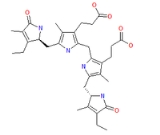
Urobilinogen
Encyclopedia
Urobilinogen is a colourless product of bilirubin
reduction. It is formed in the intestines by bacteria
l action. Some urobilinogen is reabsorbed, taken up into the circulation and excreted by the kidney. This constitutes the normal "enterohepatic urobilinogen cycle".
Increased amounts of bilirubin are formed in hemolysis
, which generates increased urobilinogen in the gut. In liver disease (such as hepatitis), the intrahepatic urobilinogen cycle is inhibited also increasing urobilinogen levels. Urobilinogen is converted to the yellow pigmented urobilin
apparent in urine.
The urobilinogen is reduced to stercobilinogen
in the intestine and is then oxidized to brown stercobilin
, which gives the feces their characteristic color.
In biliary obstruction, below-normal amounts of conjugated bilirubin reach the intestine for conversion to urobilinogen. With limited urobilinogen available for reabsorption and excretion, the amount of urobilin found in the urine is low. High amounts of the soluble conjugated bilirubin enter the circulation where they are excreted via the kidneys. These mechanisms are responsible for the dark urine and pale stools observed in biliary obstruction.
Low urine urobilinogen may result from complete obstructive jaundice or treatment with broad-spectrum antibiotics, which destroy the intestinal bacterial flora. (Obstruction of bilirubin passage into the gut or failure of urobilinogen production in the gut.)
Low urine urobilinogen levels may result from congenital enzymatic jaundice (hyperbilirubinemia syndromes) or from treatment with drugs that acidify urine, such as ammonium chloride
or ascorbic acid
.
Elevated levels may indicate hemolytic anaemia (excessive breakdown of red blood cells), overburdening of the liver, increased urobilinogen production, re-absorption - a large hematoma
, restricted liver function, hepatic infection, poisoning or liver cirrhosis.
Bilirubin
Bilirubin is the yellow breakdown product of normal heme catabolism. Heme is found in hemoglobin, a principal component of red blood cells. Bilirubin is excreted in bile and urine, and elevated levels may indicate certain diseases...
reduction. It is formed in the intestines by bacteria
Bacteria
Bacteria are a large domain of prokaryotic microorganisms. Typically a few micrometres in length, bacteria have a wide range of shapes, ranging from spheres to rods and spirals...
l action. Some urobilinogen is reabsorbed, taken up into the circulation and excreted by the kidney. This constitutes the normal "enterohepatic urobilinogen cycle".
Increased amounts of bilirubin are formed in hemolysis
Hemolysis
Hemolysis —from the Greek meaning "blood" and meaning a "loosing", "setting free" or "releasing"—is the rupturing of erythrocytes and the release of their contents into surrounding fluid...
, which generates increased urobilinogen in the gut. In liver disease (such as hepatitis), the intrahepatic urobilinogen cycle is inhibited also increasing urobilinogen levels. Urobilinogen is converted to the yellow pigmented urobilin
Urobilin
Urobilin is a yellow linear tetrapyrrole, resulting from the breakdown of heme, a cyclic tetrapyrrole.Urobilin is produced when Urobilinogen is oxidized by intestinal bacteria; it can also be...
apparent in urine.
The urobilinogen is reduced to stercobilinogen
Stercobilinogen
Stercobilinogen is a chemical created by bacteria in the gut. It is made of broken-down hemoglobin. It is further processed to become the chemical that gives feces its brown color....
in the intestine and is then oxidized to brown stercobilin
Stercobilin
Stercobilin is a tetrapyrrolic bile pigment and is one end-product of heme catabolism. It is the chemical responsible for the brown color of human fecal material and was originally isolated from feces in 1932...
, which gives the feces their characteristic color.
In biliary obstruction, below-normal amounts of conjugated bilirubin reach the intestine for conversion to urobilinogen. With limited urobilinogen available for reabsorption and excretion, the amount of urobilin found in the urine is low. High amounts of the soluble conjugated bilirubin enter the circulation where they are excreted via the kidneys. These mechanisms are responsible for the dark urine and pale stools observed in biliary obstruction.
Low urine urobilinogen may result from complete obstructive jaundice or treatment with broad-spectrum antibiotics, which destroy the intestinal bacterial flora. (Obstruction of bilirubin passage into the gut or failure of urobilinogen production in the gut.)
Low urine urobilinogen levels may result from congenital enzymatic jaundice (hyperbilirubinemia syndromes) or from treatment with drugs that acidify urine, such as ammonium chloride
Ammonium chloride
Ammonium chloride NH4Cl is an inorganic compound with the formula NH4Cl. It is a white crystalline salt that is highly soluble in water. Solutions of ammonium chloride are mildly acidic. Sal ammoniac is a name of natural, mineralogical form of ammonium chloride...
or ascorbic acid
Ascorbic acid
Ascorbic acid is a naturally occurring organic compound with antioxidant properties. It is a white solid, but impure samples can appear yellowish. It dissolves well in water to give mildly acidic solutions. Ascorbic acid is one form of vitamin C. The name is derived from a- and scorbutus , the...
.
Elevated levels may indicate hemolytic anaemia (excessive breakdown of red blood cells), overburdening of the liver, increased urobilinogen production, re-absorption - a large hematoma
Hematoma
A hematoma, or haematoma, is a localized collection of blood outside the blood vessels, usually in liquid form within the tissue. This distinguishes it from an ecchymosis, which is the spread of blood under the skin in a thin layer, commonly called a bruise...
, restricted liver function, hepatic infection, poisoning or liver cirrhosis.

